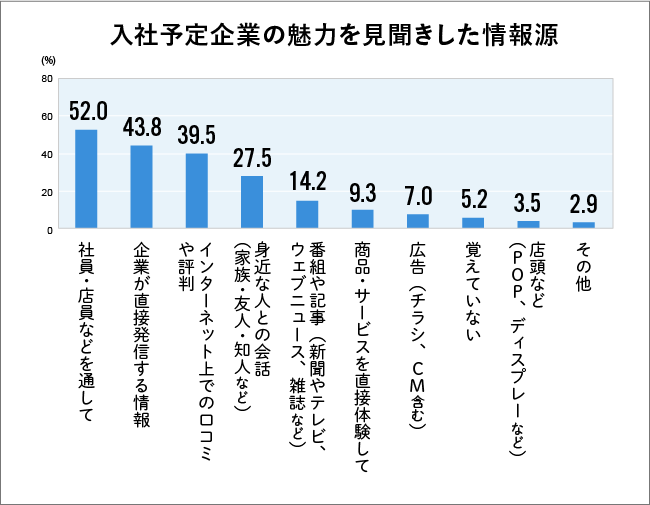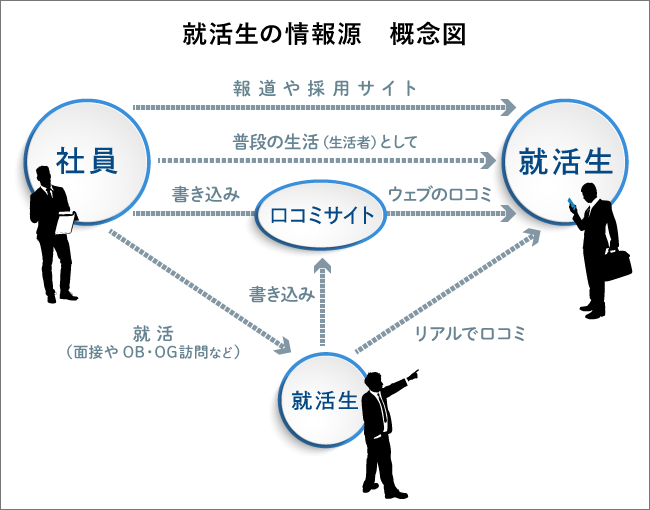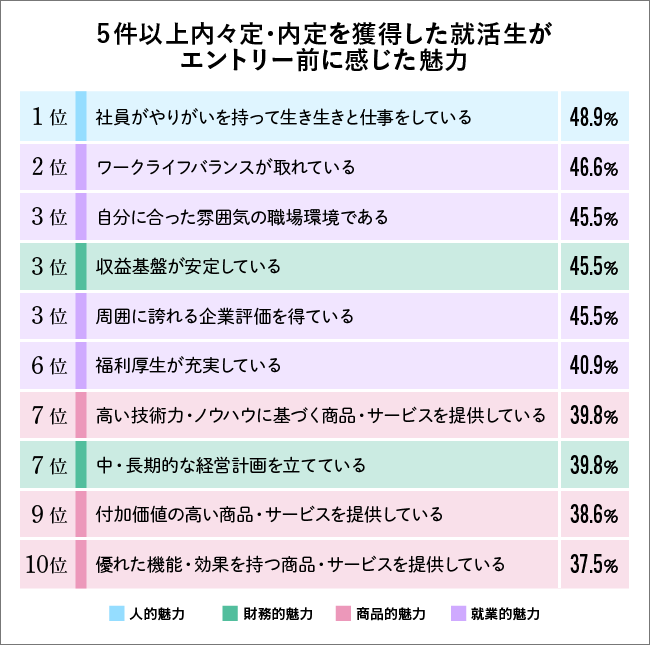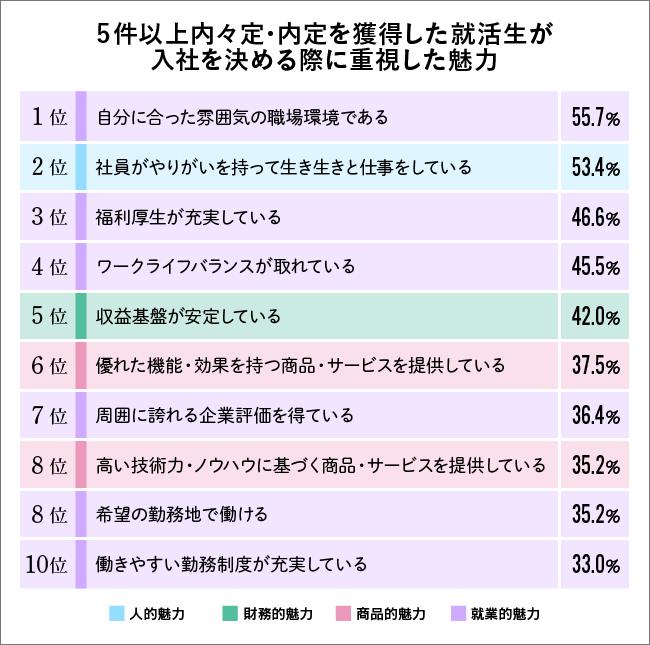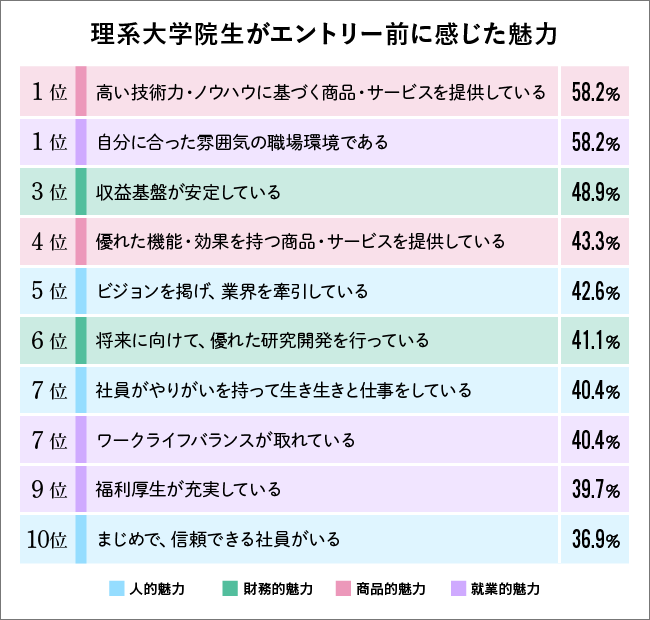In Part 1, we discussed how job seekers are becoming increasingly important stakeholders for companies amid labor shortages and changes in the information environment, and how recruitment activities also impact a company's overall branding.
Part 2 analyzes the information sources of job seekers based on a survey of 1,000 candidates who received preliminary or formal job offers, conducted by Dentsu Inc. PR's Corporate Communications Strategy Research Institute. It explains key points for recruitment activities that connect to corporate branding from the perspective of information exposure.
What media most influenced job seekers who ultimately decided to join a company?
What channels should companies use to communicate information to job seekers? Let's examine the survey results, excluding media specialized in new graduate recruitment information.
The top reasons job seekers found their prospective employer appealing were: 1st "Employees/staff" (52.0%), 2nd "Information directly released by the company" (43.8%), 3rd "Online word-of-mouth and reputation" (39.5%), 4th "Conversations with people close to them" (27.5%), and 5th "TV programs or articles" (14.2%).
When asked which media source (excluding comprehensive job search sites specializing in new graduate recruitment) made them feel most attracted to a company, "review sites" ranked first (197 respondents), chosen by approximately one in five people. Not only were new graduate-focused review sites, where job seekers' posts reveal the reality of recruitment activities, frequently cited, but many job-hunter review sites were also mentioned. Job-hunter review sites, where current and former employees share insights into a company's actual conditions, are becoming increasingly important even in new graduate recruitment.
This result indicates that job seekers grasp the real nature of companies. It suggests that appealing solely based on imagined appeal (FACT) that the company doesn't actually possess could, conversely, damage the company's brand image.
What influences job seekers in the position of "choosing" companies is ○○○○
Next, we analyzed information sources specifically among students who had received five or more conditional or formal job offers and were in a position to "choose" companies.
For these students in a position to choose companies, the information sources they tended to value most were, from the companies themselves, "Recruiter interviews" and "Visits with alumni," and from sources outside the companies, "Word-of-mouth sites."
All of these ultimately lead back to "employees."
The points of contact between employees and job seekers are diverse: people interviewed by media, those featured on company websites, service staff at retail locations, recruitment managers, interviewers, alumni met during visits, recruiters, and more.
Furthermore, experiences a job seeker has with an employee can be shared via review sites or social media, reaching an unspecified number of other job seekers—this too constitutes indirect contact with employees. Additionally, experiences shared by close seniors or peers become real-life word-of-mouth.
Therefore, it is essential that employees embody the company's brand through Internal Branding® (※1) before interacting with job seekers. This fosters positive feelings toward the company among job seekers, potentially turning them into future key business partners ( see Part 1 for why job seekers are important stakeholders).
Furthermore, Internal Branding® requires the thorough permeation of corporate philosophy and vision among employees. Therefore, employee workshops that revisit these philosophies and visions are crucial. Implementing such workshops as a step within strategic recruitment activities can also serve as a catalyst for initiating this process.
※1 Activities where employees deepen their understanding of the company's philosophy and vision, act as embodiments of the corporate brand in accordance with these principles, and build a strong corporate brand from within. (Registered trademark of Dentsu Inc. Public Relations)
The appeal a company holds varies depending on the job-hunting stage and attributes of the student
Next, we explain what aspects of a company job seekers find appealing. Students who received 5 or more preliminary offers or formal offers and were in a position to "choose" companies reported the following "appeal felt before applying" and "appeal emphasized when deciding to join":
The appeal job seekers with 5+ offers sought from companies before applying ranked well across four balanced categories: "Human Appeal," "Financial Appeal," "Product Appeal," and "Employment Appeal." This mirrors the overall job seeker ranking (see Part 1). This shows that job seekers with 5+ offers also evaluate corporate appeal from multiple angles.
Conversely, in the top 10 factors prioritized by job seekers who received 5 or more offers when deciding to join a company, "Employment Appeal" ranked in 6 positions.
This means that to attract top-tier job seekers who receive five or more offers, companies must not only emphasize "employment appeal" but also effectively communicate their "human appeal," "financial appeal," and "product appeal" in their daily corporate activities before the application stage. Otherwise, they may not even get the application. It's not just the job hunting period; the company's day-to-day activities themselves are being scrutinized.
Incidentally, among science and engineering graduate students—highly sought after by companies in recent years—the most valued factor was "providing products and services based on high technical capabilities and know-how." Items listed reflect their desire to assess whether they can pursue their desired research and development after joining: products and services backed by innovative, high technical and R&D capabilities, and the corporate management supporting them.
Thus, companies must understand job seekers' stages and attributes, communicating tailored appeal (FACT) aligned with their aspirations. This approach not only secures desired talent but also enables corporate branding through recruitment activities.
In the final Part 3, recruitment consultant and analyst Masanao Tanide, who collaborated on developing the "Recruitment Version Corporate Appeal Branding Model," will introduce the latest trends among job seekers and companies. Based on these insights, he will explain key points for corporate branding in recruitment activities.

